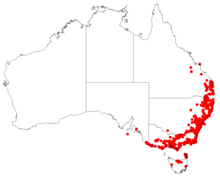Billardiera scandens
Billardiera scandens, commonly known as apple berry or apple dumpling,[1] is a small shrub or twining plant of the Pittosporaceae family which occurs in forests in the coastal and tableland areas of all states and territories in Australia, apart from the Northern Territory and Western Australia.[2] It has a silky touch and appearance that becomes more brittle as the dense growth matures. The inflorescence consists of single or paired yellow flowers, pink-tinged yellow sepals and bright yellow petals and is attached to a hairy drooping peduncle. The summer flush produces fruit of oblong berries up to 30 mm long, initially green in colour and covered in fine hair - somewhat akin to a tiny kiwifruit in appearance.[3][4][5]
| Apple berry | |
|---|---|
.jpg) | |
| Billardiera scandens growing in Como | |
| Scientific classification | |
| Kingdom: | Plantae |
| Clade: | Tracheophytes |
| Clade: | Angiosperms |
| Clade: | Eudicots |
| Clade: | Asterids |
| Order: | Apiales |
| Family: | Pittosporaceae |
| Genus: | Billardiera |
| Species: | B. scandens |
| Binomial name | |
| Billardiera scandens | |
 | |
| Occurrence data from Australasian Virtual Herbarium | |
Taxonomy and naming
Billardiera scandens was first formally described in 1793 by James Edward Smith, and the description was published in his book A Specimen of the Botany of New Holland. In 1819 the genus was renamed Labillardiera by Josef August Schultes, but this was later declared illegal under the laws of botanical nomenclature. A cladistic analysis of the genus in 2004 resulted in an expanded circumscription of this species, encompassing material that was previously placed in B. angustifolia, B. brachyantha, B. daphnoides, B. latifolia and B. canariensis. All of these names are now considered taxonomic synonyms of B. scandens.[6]
There are two varieties:
- Billardiera scandens var. scandens - Leaves linear to ovate with lower surface glabrous pubescent;
- Billardiera scandens var. sericata - Leaves elliptic to narrow-elliptic with lower surface silky-villous.[7]
Uses
The flowers and fruit of apple berry are attractive to both birds and people. The fruits, which only ripen after dropping to the ground, are valued as an Australian bush food and are variously described as tasting like stewed apples or kiwifruit. They were eaten by Australian Aboriginals either in their ripened state or by roasting the unripened fruit. Botanist Joseph Maiden noted in 1898 that children of European settlers in the Port Jackson area, where it is commonly found, had been eating the berries since the foundation of the settlement in 1788.[8] He also noted in 1889 that it was commonly referred to as "Apple Berry" and that "The berries are acid and pleasant when fully ripe. From their shape children call them "dumplings." When unripe, a small quantity of the juice produces very disagreeable and persistent heartburn."[9]
Cultivation
Apple berry is a popular choice in Australian gardens, especially those favouring indigenous plants as a rambling yet non-dominant shrub, especially beneath eucalypts and between other native species. The species is also grown in gardens around the world and is easily propagated and maintained. It is an adaptable plant, and will withstand a wide range of conditions, including mild frost, semi-shade and periods of dryness although it performs best in moist conditions. It also tolerates a wide variety of soils, including clay.[10][5]
References
- "Australian Plant Common Names Database". Retrieved 2007-07-13.
- Wrigley J.W. & Fagg M. (1979). Australian Native Plants. William Collins Publishers Sydney, Australia. ISBN 0-00-216416-7.
- Conn, Barry J. "Billardiera scandens". Royal Botanic Garden Sydney. Retrieved 4 February 2018.
- "Billardiera scandens". Royal Botanic Gardens Victoria. Retrieved 4 February 2018.
- "Billardiera scandens". Australian Native Plants Society Australia. Retrieved 4 February 2018.
- "Billardiera scandens Sm". Australian Plant Name Index (APNI), IBIS database. Centre for Plant Biodiversity Research, Australian Government.
- Plant profile: Billardiera scandens, NSW Flora Inline
- Low,T. (1991). Wild Food Plants Of Australia. Australia: Angus & Robertson. ISBN 0-207-16930-6.
- J. H. Maiden (1889). The useful native plants of Australia : Including Tasmania. Turner and Henderson, Sydney.
- Greig, D. (1987). The Australian Gardener’s Wildflower Catalogue. Australia: Angus & Robertson. ISBN 0-207-15460-0.
| Wikisource has original works on the topic: Billardiera scandens |
External links

